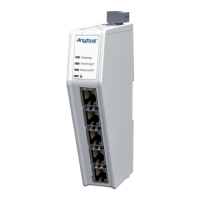
Do you have a question about the Anybus Communicator and is the answer not in the manual?
| Protocols Supported | PROFINET, EtherNet/IP, Modbus TCP |
|---|---|
| Serial Interfaces | RS-232, RS-485 |
| Ethernet Protocols | Modbus TCP, EtherNet/IP, PROFINET |
| CAN Protocols | CANopen |
| Operating Temperature | -25°C to +70°C |
| Storage Temperature | -40°C to +85°C |
| Humidity | 5% to 95% non-condensing |
| Power Supply | 24V DC |
| Enclosure | Plastic |
| Protection Class | IP20 |
Defines the equipment's purpose as a communication interface and gateway.
Provides essential safety precautions, including power, ESD, and grounding.
Lists the required cables for connecting the device.
Configures IP settings for the PROFINET network, including DHCP and manual options.
Configures IP settings for the EtherNet/IP network, including DHCP and manual options.
Explains how to export the GSDML file for PROFINET PLC configuration.